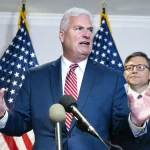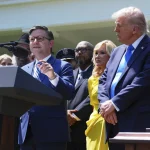
–>
June 28, 2023
In the 121 years since 1902, the federal government’s spending has increased from 6.9 percent of GDP to over 50 percent recently. Excessive government spending is directly related to tyranny.
‘); googletag.cmd.push(function () { googletag.display(‘div-gpt-ad-1609268089992-0’); }); document.write(”); googletag.cmd.push(function() { googletag.pubads().addEventListener(‘slotRenderEnded’, function(event) { if (event.slot.getSlotElementId() == “div-hre-Americanthinker—New-3028”) { googletag.display(“div-hre-Americanthinker—New-3028”); } }); }); }
The following chart gives an overview of all government spending in the 20th century:
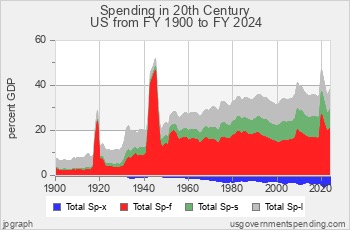
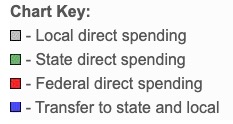
Chart 2.21: 20th Century Government Spending
The chart shows that federal spending was modest until World War I, when it increased temporarily, only to fall back again in the 1920s.
Roosevelt’s New Deal increased spending but, in the lead-up to WWII, the federal government’s direct spending was less than half of total government expenditures (local, state, and federal). The enormous demands of World War II saw federal government spending peak at just under 52 percent of GDP in 1945.
‘); googletag.cmd.push(function () { googletag.display(‘div-gpt-ad-1609270365559-0’); }); document.write(”); googletag.cmd.push(function() { googletag.pubads().addEventListener(‘slotRenderEnded’, function(event) { if (event.slot.getSlotElementId() == “div-hre-Americanthinker—New-3035”) { googletag.display(“div-hre-Americanthinker—New-3035”); } }); }); }
Federal spending immediately dropped back to 21 percent of GDP after WWII, and then steadily climbed to a peak of 35 percent of GDP at the bottom of the 1980-82 recession. Thereafter, government spending continued to account for approximately 35% of the GDP until the mortgage meltdown of 2008.
In the aftermath of 2008’s bank and auto bailouts, federal government spending rose to 41 percent of GDP, although eventually moderating to about 36 percent of GDP. However, when COVID hit in 2020, federal government spending went to WWII levels of just over 50 percent of GDP (see here for more details).
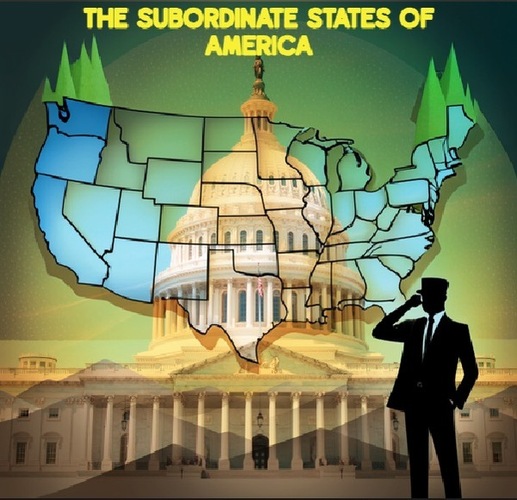
Image by Andrea Widburg.
In 2021, the federal government directly employed about 2.85 million people. However, the cost of our federal government extends beyond the direct connection between federal taxes and expenditures. Federal regulations govern how states, territories, and smaller government entities operate. The 50 states along with D.C., the territories (Puerto Rico, Guam, etc.), 19,495 incorporated cities and towns, 3332 counties or parishes, and thousands of school boards and other state and local entities are all effectively federal subsidiaries to one degree or another thru costly federal regulations, expenditures, and police power.
That means that taxpayers aren’t supporting just a couple of million federal employees. As of 2021, 18.28 million people worked for state and local governments in the United States. Furthermore, there are millions of contract workers who provide infrastructure and myriad services to all these governments.
A centralized government is an enclave of laws, regulations, and employees. Many of these employees (courts and police) enforce the onerous regulations that cover almost every aspect of our lives and suck the treasure from the productive populace to finance it. This represents a tyranny of almost absolute control, as the pandemic shutdowns and forced “virus” injections have shown. Biden continues to issue numerous other unconstitutional orders from D.C. Chaos seems to be the goal in the effort to redo America. Do Obama and Biden want to create a dictatorship? (Tucker Carlson’s satirical take is definitely food for thought.)
Could we have foreseen and prevented what’s happened? The Founders, after all, thought our Republic had 200 years before an inevitable collapse. The Founders were pessimistic about the survival of our republic. Franklin said,
‘); googletag.cmd.push(function () { googletag.display(‘div-gpt-ad-1609268078422-0’); }); document.write(”); googletag.cmd.push(function() { googletag.pubads().addEventListener(‘slotRenderEnded’, function(event) { if (event.slot.getSlotElementId() == “div-hre-Americanthinker—New-3027”) { googletag.display(“div-hre-Americanthinker—New-3027”); } }); }); } if (publir_show_ads) { document.write(“
I agree to this Constitution … and I believe, further, that this is likely to be well administered for a course of years, and can only end in despotism, as other forms have done before it, when the people shall become so corrupted as to need despotic government, being incapable of any other.
In the 250 years from George III to Biden I, we’ve gone from “taxation without representation” to “taxation without representation.” How depressing.
We threw off British rule and were generally happy, although the choice to continue race-based slavery bedeviled us, so we could not avoid the Civil War. The outcome (industrial north with streams of new immigrants v. rural south) was inevitable.
Once it ended, an overwhelming result of the Civil War was that the D.C. government became more powerful. Tyranny took a while to brew, but Woodrow Wilson helped it along with his view on the administrative state—a complex government required a civil service with the technical expertise that the citizenry could not possibly have to make the appropriate decisions.
The Great Depression was fueled by the Federal Reserve’s depressing the money supply and killing the banks, despite knowing better. (See Milton Friedman & Anna Schwartz, A Monetary History of the United States 1867-1960, Princeton University Press, 1963.) But the fix was in, and the market system, not the government, was blamed, so the solution was more centralized government, with alphabet agencies sprouting like weeds. FDR and his cadre of lawyers knew nothing about markets except that they had to be controlled and, in many ways, thwarted.
But still, the central government was small—small until WWII. In fact, the full-scale decline of America can be traced to the war. Once we got into the war, the central government expanded phenomenally. Also, centralized control expanded. A good example is how Japanese American citizens in California suffered tremendously from what can only be described as racial hysteria after Pearl Harbor, with FDR and the Supreme Court leading the central government charge.
After the war, there was a brief respite as spending fell back to the 20 percent level, and the golden age of the 1950s ensued. It wasn’t perfect but we can have as a reasonable goal the 1950s, except with civil rights and reasonable environmental regulations added. Of course, if the CIA really did kill JFK (as RFK, Jr. suggests), the tyrannical rot was already firmly in place.
A large central government based on progressive taxes and borrowing is inevitably a government that redistributes society’s wealth and income with the justification that some deserve government aid, while others should finance that aid. Power and money feed on each other. Political power makes a large central government. A large central government makes for political power. Corruption is part and parcel of this cycle. It doesn’t matter whether a large central government is bad for the country. D.C.’s size and power mean it rules regardless of the fact that half the country disagrees.
LBJ’s Great Society significantly advanced the large central government spending program. It also devastated the black family. Nixon didn’t pull back. He created the EPA, which later opted for overkill regulations that devastate the economy, something only possible with a large central government.
Since the 1960s, government spending and tyranny have grown. They’re unstoppable.
Trump mounted a holding action amid unprecedented unconstitutional attacks. The 2020 election, his indictment, and the plea deal for Hunter all represent tyranny on steroids. Trump’s reelection in 2024 is unlikely if organized voter fraud holds sway. If he wins, the Deep State will again try to destroy him.
Even the Supreme Court, despite Trump appointees, has been Deep Stated. The justices do not have saving constitutionalism as a goal. Apparently, they fear the mob banging on their doors more than they revere the Constitution.
An agreed-upon, peaceful national separation is possible. One suggestion is to apply the Swiss Canton approach whereby agreeable groups join and rule locally. Unfortunately, without divine intervention, it’s hard to see a separation without violence.
Given history and man’s nature, Thomas Jefferson expected tyranny to appear in America and believed a repeat revolution would be necessary to counter tyranny. If other solutions do not prevail, what would a revolutionary Boston Tea Party look like today? Are the January 6 prosecutions powerful enough to prevent Jefferson’s prediction from coming true? If so, are we condemned to a failed republic and the bread and circuses of a continuing tyranny?
<!–
–>
<!– if(page_width_onload <= 479) { document.write("
“); googletag.cmd.push(function() { googletag.display(‘div-gpt-ad-1345489840937-4’); }); } –> If you experience technical problems, please write to helpdesk@americanthinker.com
FOLLOW US ON
<!–
–>
<!– _qoptions={ qacct:”p-9bKF-NgTuSFM6″ }; ![]() –> <!—-> <!– var addthis_share = { email_template: “new_template” } –>
–> <!—-> <!– var addthis_share = { email_template: “new_template” } –>


